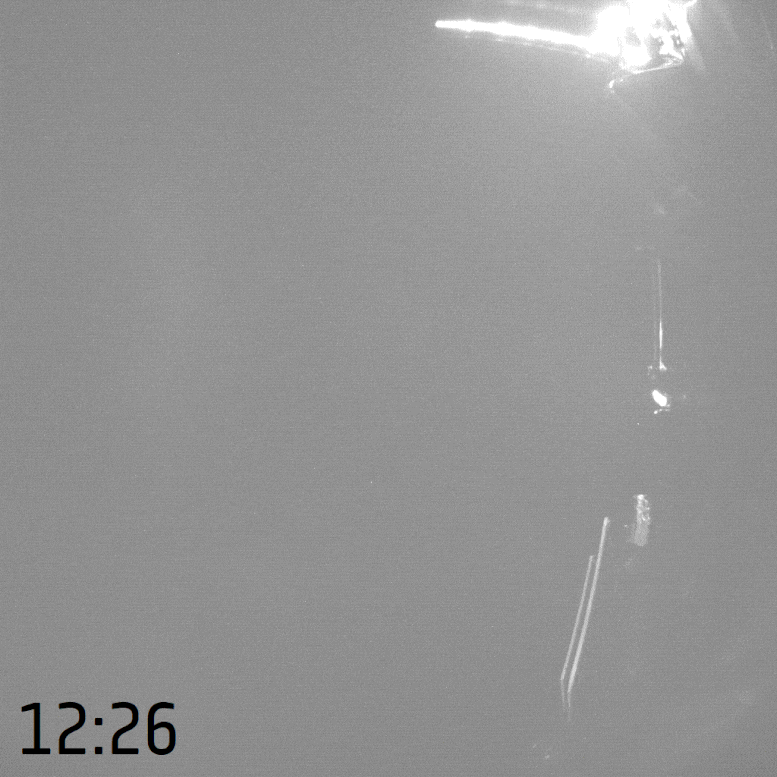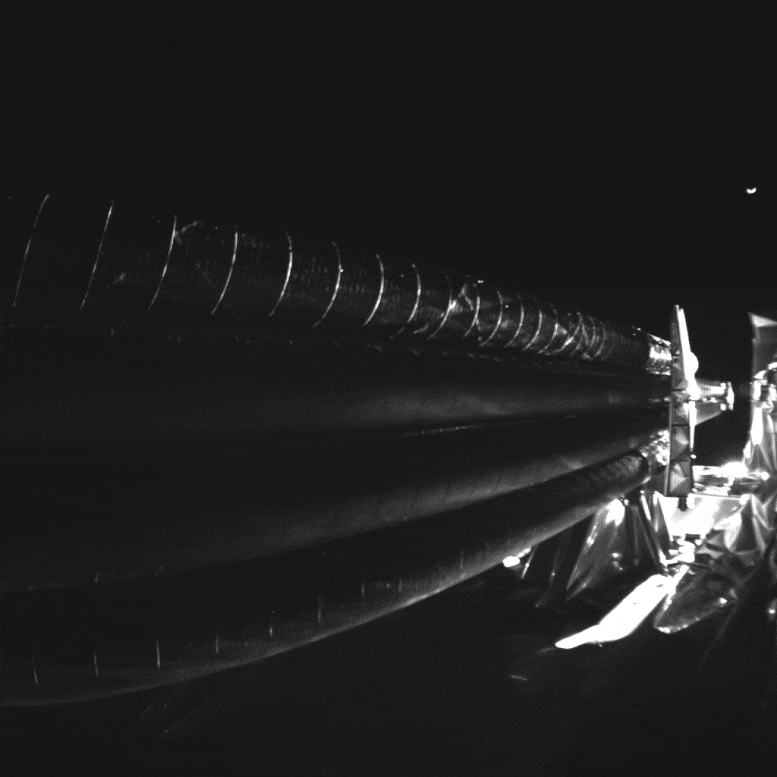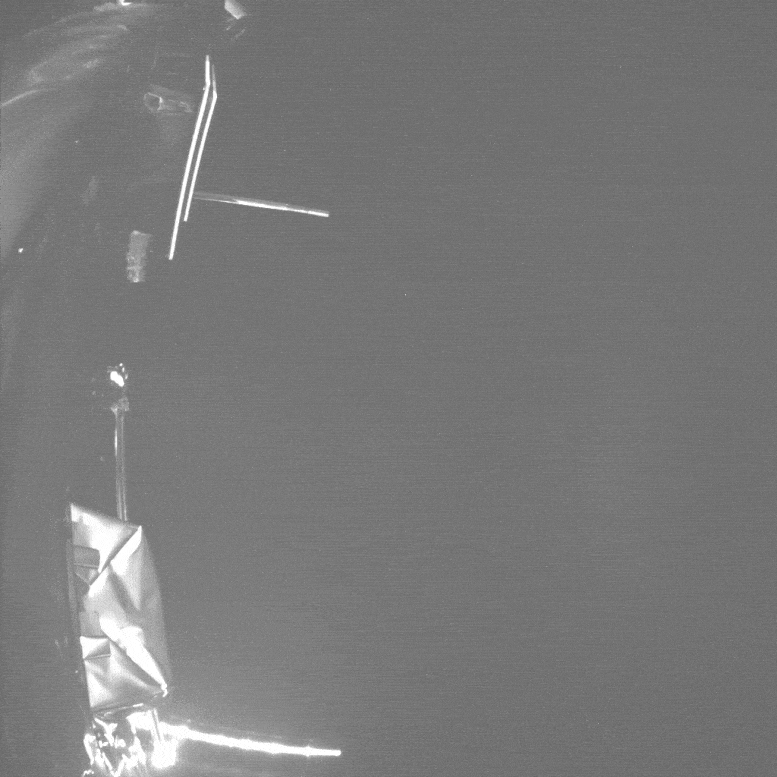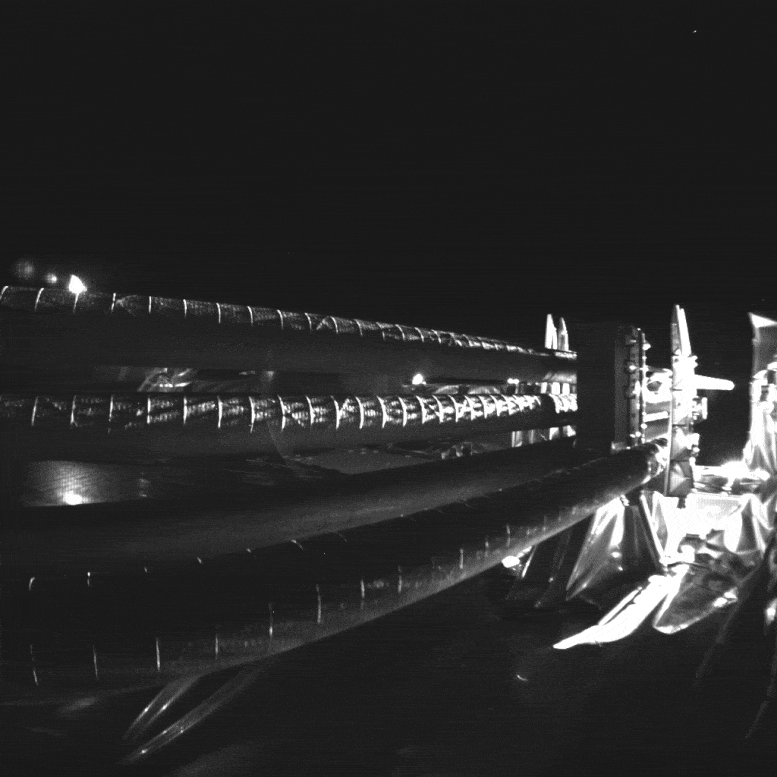After the Radar for Icy Moon Exploration (RIME) antenna on ESA’s Juice mission encountered deployment issues post-launch, combined efforts from engineers at ESA, Airbus, and SpaceTech successfully rectified the problem. Suspecting ice formation as the issue, they heated the spacecraft by sun exposure, but when this didn’t work, they continued with the planned antenna deployment, which eventually dislodged the stuck pin and successfully deployed the antenna. (Juice flyby of Ganymede, artist’s impression.) Credit: ESA
When the RIME antenna on ESA’s Juice mission failed to deploy a few days after launch, the engineering teams faced the mighty challenge to understand the fault and rectify it. At stake was a chance to see inside Jupiter’s mysterious icy moons.
The stakes were already high before the spacecraft ever left the ground. ESA’s Jupiter Icy Moons Explorer (Juice) was designed by Airbus to conduct an unprecedented investigation of the Jupiter system and its family of icy moons.
A key to that investigation is the Radar for Icy Moon Exploration (RIME) antenna, which is part of Juice’s comprehensive suite of ten science instruments. Once in the Jupiter system, RIME will be used to remotely probe the subsurface of Jupiter’s icy moons. Its radar signals will penetrate the moons to a depth of 9 km, and reveal details of between 50 and 140 m across. This will give insight into their geology and provide unique data to understand the habitability of these remote, icy moons.

Juice’s RIME antenna, folded up ready for deployment. ESA’s Jupiter Icy Moons Explorer, Juice, captured this image with its Juice monitoring camera 2 (JMC2) shortly after launch on April 14, 2023. Credit: ESA/Juice/JMC
But to succeed in collecting this data, scientists had to first get the spacecraft and its instruments into space – and that meant folding up some of the hardware.
At 16 m in length, the RIME antenna was too long to fit inside the nose cone of the Ariane 5 rocket that launched Juice into space. It was therefore constructed in two booms of four segments each. Of those eight segments, three would deploy on one side of the spacecraft, three on the other side, and two would remain fixed on the spacecraft. For launch, the three deployable segments were folded back onto the fixed segment and held in place by two brackets.
Once in space, devices called non-explosive actuators (NEAs) would be remotely activated one after the other from the European Space Operations Centre (ESOC), Darmstadt, Germany. Each NEA would remove a holding pin from its bracket, allowing that section to spring into place.
And that’s where the problems began.

The procedure to deploy Juice’s RIME antenna began on April 17, 2023, three days after the launch, and with everything having proceeded smoothly up until that point. Continuing this trend, the first step went without a hitch. Two monitoring cameras, mounted onboard the spacecraft, were used to follow the RIME deployment. From the downloads, the antenna segment was visible on one image, and then not on the next. In between the images, the NEA had fired, the pin had released and the antenna segment had snapped into place. A check of the external camera’s image showed the segment in place, and the telemetry data also confirmed this. It showed that the spacecraft was oscillating as expected from the sudden deployment of the boom, and that the Attitude and Orbit Control System (AOCS) was correcting for the last of these movements. Credit: ESA/Juice/JMC
Ronan Le Letty, Senior Mechanisms Engineer for ESA and part of the Juice team, was at ESOC during the RIME deployment, advising the flight control team who were receiving telemetry from the spacecraft’s various onboard sensors and sending Juice commands.
The procedure began on April 17, 2023, three days after the launch and with everything having proceeded smoothly up until that point.
Continuing this trend, the first step went without a hitch. Two monitoring cameras, mounted onboard the spacecraft, were used to follow the RIME deployment. From the downloads, the antenna segment was visible on one image, and then not on the next. In between the images, the NEA had fired, the pin had released and the antenna segment had snapped into place. A check of the external camera’s image showed the segment in place, and the telemetry data also confirmed this. It showed that the spacecraft was oscillating as expected from the sudden deployment of the boom, and that the Attitude and Orbit Control System (AOCS) was correcting for the last of these movements.
Satisfied, the team moved on to the second segment.
The command was given to fire the actuator. The telemetry arrived before the images, but something was wrong. The expected oscillation was not showing. A few seconds later, the camera image came back. The boom segment was still clearly visible in its stowed configuration. The deployment had failed.
“You experience a state of disbelief,” says Ronan, “The most unwanted situation is happening. We checked the picture two, three, four times. We tried again to activate the actuator, but nothing happened.”

Juice’s stuck but moving RIME antenna is captured by the Juice Monitoring Camera on board the spacecraft. This animation shows the radar’s movements in five photos taken across April 17–21, as teams on Earth work through steps in Juice’s deployment. Credit: ESA/Juice/JMC
Also watching in a state of professional disbelief was the team at Airbus Defence and Space, Toulouse, France. Chosen as the spacecraft’s prime contractor in 2015, they were responsible for leading the design, construction, and testing of the spacecraft and bringing in other companies to supply components, systems and instruments as needed.
“We knew that we had to quickly try to understand what had happened, and then try to find a workaround,” says Frédéric Faye, Airbus’s chief engineer for Juice.
The very next morning, with the disbelief banished from their minds, the teams gathered online for a teleconference to share their insights and discuss the anomaly. On one hand, they knew they had to find some way to free the stuck segment, but on the other, they knew that they could not do anything that would compromise the deployment of the other segments, or indeed the rest of the spacecraft.
The first thought that occurred to the teams was that perhaps some ice had formed on the pin holding the segment in place. Every time a spacecraft leaves Earth, it finds itself in a cold, airless environment. This sudden and dramatic loss of air pressure means that a small amount of water vapor will suddenly escape from the material used to make the craft. This can then freeze onto the incredibly cold surfaces of the spacecraft.
Since there are no heaters on the spacecraft near RIME, removing the ice would mean rotating the spacecraft so that the antenna faced the Sun. But, the surface of the spacecraft holding RIME was designed to be a ‘cold face’, meaning that it was never intended to be exposed to the direct sunlight just after launch. Nor were the components, instruments and systems that were attached to it.
After several days of study, the team began gradually slewing the spacecraft so that the surface was illuminated. “We did eight slews over two weeks to illuminate the RIME bracket,” says Angela Dietz, Spacecraft Operations Manager at ESOC. Each time they exposed the surface for longer, carefully watching the telemetry from the onboard sensors to understand the limits of this operation. At first, the maneuver lasted just 25 minutes. By the end, they felt comfortable exposing the surface for 73 minutes at a time.
Simultaneously, other possible recovery scenarios were being contemplated.
If it were not ice holding RIME shut, and the pin had simply stuck, then perhaps shaking the spacecraft would jog it loose – although the word ‘shaking’ is too extreme to describe the actual motion.
The spacecraft weighs six tonnes and the thrusters onboard can only rock it back and forth very gently. Nevertheless, the teams felt it was worth trying. The stuck pin probably only needed moving by a millimeter or two, but the teams had to be careful. They could not risk harming anything else with a violent jolt of the spacecraft. So, as the team had done with the heating, they began testing this maneuver cautiously.
“We did several thruster firings and used the main engine, often linked with the heating up slews. The thrusters were even fired in a certain sequence to try to shake off the stacked boom, but we only saw small movements within the bracket,” says Angela.
And so the team moved on to other ideas.
The manufacturer of the antenna, German company SpaceTech, also proposed a recovery plan. Effectively, it was to continue deploying the other four sections of the antenna as if nothing had happened. They knew that as each NEA fired, it would produce a small mechanical shock in the rest of the antenna that could dislodge the stuck pin.
Then, the manufacturer made a breakthrough. The engineers at SpaceTech managed to reproduce the anomaly with a model of the antenna that had been used for testing and confirmed that the firing of the closest NEA usually managed to dislodge the stuck pin. It was also identified that to increase the chances of a successful outcome, the antenna should be heated by exposure to sunlight.
This was because although the engineering model had been fully tested at the cold temperatures of space, the actual flight model had not. The team concluded that the extremely cold conditions encountered during the failed NEA release might have been a contributing factor, and so the antenna should be warmed by the Sun before all future actuations to get it as close to ‘room temperature’ as possible, where they knew it worked.
Armed with several ideas for how to recover the instrument, the teams decided to meet in person to decide the way forward. At a technical workshop held at SpaceTech, the teams decided to try the heating first. If that did not work, they would proceed with firing the other NEAs, having warmed them first with sunlight. “This exercise to put down a plan and get all the teams working towards it was really beneficial,” says Ronan.
It was now several weeks since the anomaly had occurred and pressure was mounting. The mission had a timetable to keep and as important as RIME is, it was only one instrument on the spacecraft. “To me this was the most complicated thing during the recovery,” says Guillaume Chambon of Airbus’s Technical Authority Team. Guillaume was placed in charge of managing the Airbus side of the recovery. “You have to be fast enough to act because everyone is expecting you to make progress, but you need to take enough time to consider all the side effects of what you are proposing,” he says.
One afternoon, while contemplating the rescue attempt, Guillaume did indeed realize a potential problem. If they went ahead with the nominal deployment sequence, there was a chance that two segments of the antenna could collide.

On May 12 RIME was finally jolted into life when the flight control team fired a mechanical device called a ‘non-explosive actuator’ (NEA), located in the jammed bracket. This delivered a shock that moved the pin by a matter of millimeters and allowed the antenna to unfold. Credit: ESA/Juice/JMC
Recall that the RIME antenna is composed of six deploying segments, three on each side of the spacecraft. In the nominal deployment scenario, an NEA would be fired first on one side of the antenna and then on the other. However, if they did this now, and the stuck section came free, then the two sides of the antenna would be deploying together in opposite directions and could collide.
So, the teams agreed to reorder the deployment sequence, and the recovery attempts began. First, the spacecraft was heated to drive off any ice, but the antenna remained fixed.
And so it became obvious that the only possibility to recover the antenna was to heat the antenna again, and then continue with the deployment in the hopes that the shocks from the other NEAs would unjam the pin. Their analysis had shown them that this would give the best chance of success but each NEA could only be fired once. In other words, it was all or nothing.

On May 12 RIME was finally jolted into life when the flight control team fired a mechanical device called a ‘non-explosive actuator’ (NEA), located in the jammed bracket. This delivered a shock that moved the pin by a matter of millimeters and allowed the antenna to unfold. Credit: ESA/Juice/JMC, CC BY-SA 3.0 IGO
It was around 2 pm on May 12 that the teams gathered at their respective consoles and began this final attempt. The command was sent and the teams watched the telemetry for any hint of an oscillation that would indicate success. There it was: movement on the spacecraft. But was it the correct movement? Had they dislodged the stuck segment?
When the camera downloaded, the image showed them everything they needed to know.
Total success. The three segments of the antenna that should be deployed, were deployed. “In the operations team we became quietly confident,” says Angela.
But the job was not over yet. They were only halfway through the full deployment procedure. One other NEA still needed to be fired to deploy the second boom before RIME could assume its final operating configuration. And if anything, the pressure felt by some on the team was even greater than before because now the team knew that it was possible for the pins to jam. And now that just one pin remained, it was the most critical of all.
If any of the previous ones had jammed, the team could have fired the next in sequence and hoped that the shock would finish the job – as it had on the original stuck segment. But now, there were no more NEAs to fire. Right at the finish line, they could still be defeated if the pin jammed.

Juice mission operators celebrating the successful deployment of another instrument, RPWI. Credit: ESA
It was at this point that Cyril Cavel, the Juice project manager for Airbus found himself thinking about the scientists who were depending on them. Some had even been working on the antenna for decades. “RIME was an industrial delivery to these people. Without this antenna, the radar experiment would be either very reduced or even dead. It would be far more than just a shame,” he says.
Indeed, the chance to truly learn what was below the icy surfaces of those enchanting moons could have been significantly diminished or even lost for the current generation of planetary scientists.
“We knew that, even though the RIME was one instrument out of ten, a failure to fully open the antenna would have degraded the scientific performance of the mission and compromised the – until that moment – excellent image of Juice and ESA to the external world,” says Giuseppe Sarri, ESA’s Juice Project Manager.
As a result, the team took one final precaution. By now, the final bracket had been in sunlight for its maximum permitted time that day of 73 minutes. As a result, its temperature was higher than the ambient temperature at which it had been tested in the labs in Germany. To reproduce the conditions of that lab as closely as possible, the team took the decision to rotate the spacecraft, moving the antenna away from the Sun, and wait for three to four hours for its temperature to drop.
“Those three to four hours were very long,” says Frédéric.
At the end of the wait, when the conditions were right, the command was sent.
The NEA activated, the telemetry showed Juice oscillating as the final segment deployed, the AOCS cut in and stabilised the spacecraft. Finally, the cameras confirmed the teams’ victory, RIME was now in its fully deployed configuration.
For Ronan, the relief at seeing the deployment was tinged with a familiar sense of disbelief. “It was a bit like the first day of the incident. There was a feeling of disbelief because four weeks of an enormous amount of pressure was just suddenly gone. I couldn’t quite believe it, despite seeing the pictures,” he says.
“When RIME was eventually released I could almost see tears in the eyes of my colleagues,” says Giuseppe, before adding, “But we were positive from the beginning and the Champagne was already in the fridge…”
Once the bubbly was drunk and the team suitably rested, the flight controllers at ESOC moved on to the other deployments necessary on the spacecraft, all of which have now been completed successfully. And the RIME anomaly teams at ESA, Airbus and SpaceTech, are just wrapping up their understanding of the original cause so that it can be avoided in the future on similar systems.
And the Juice mission itself is once again on a path to complete success.





